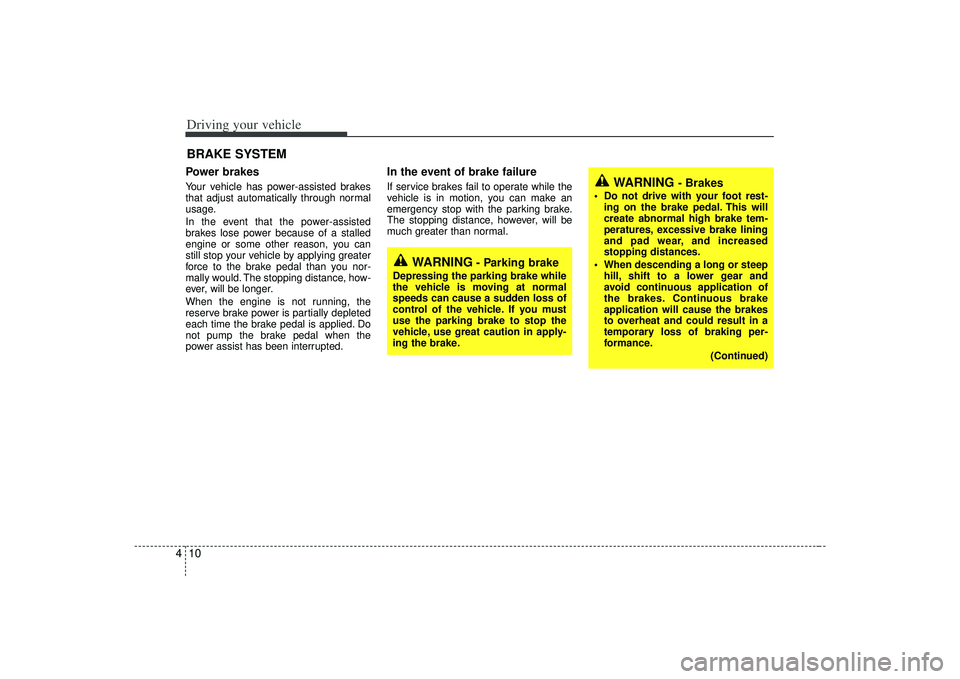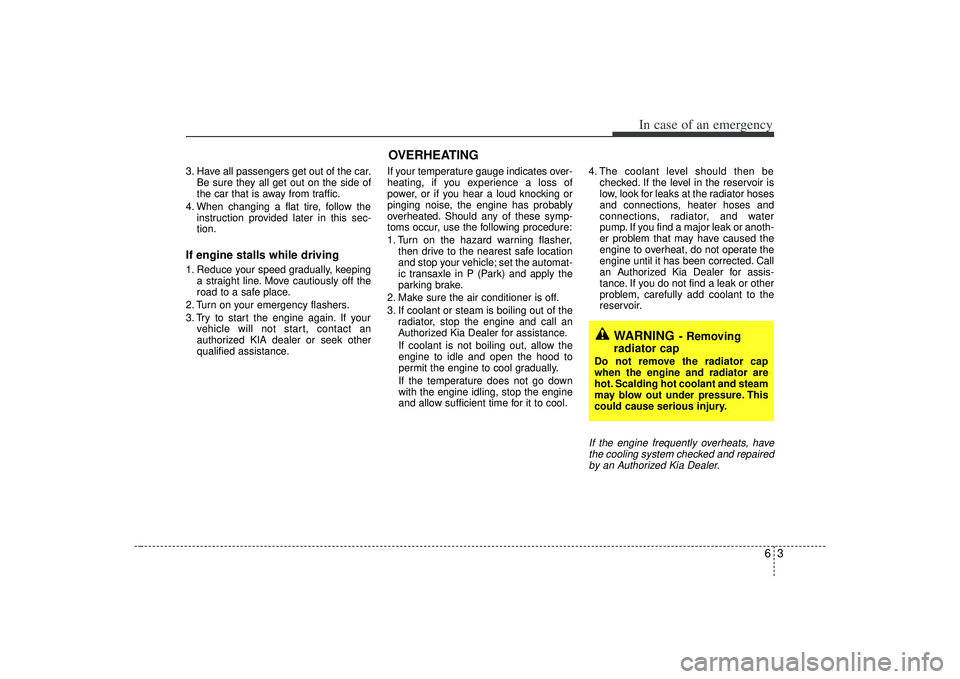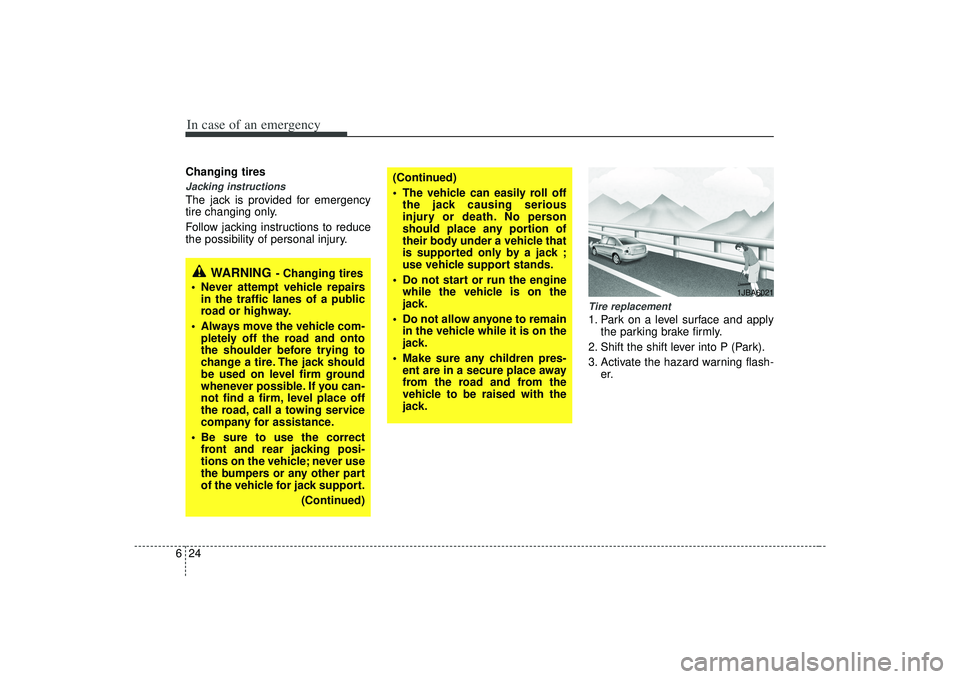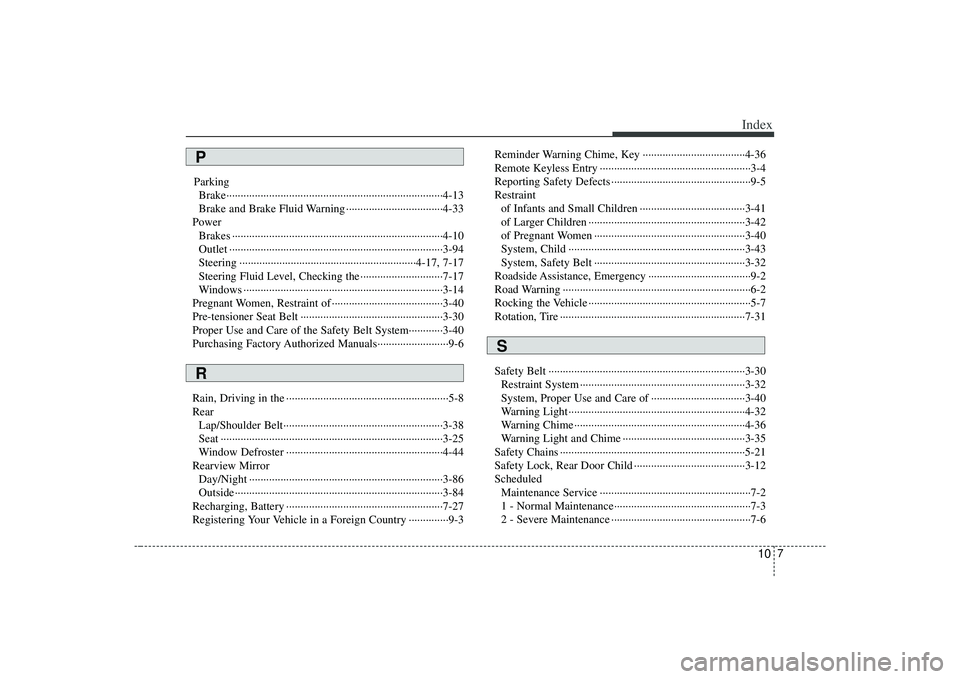park assist KIA AMANTI 2009 Owners Manual
[x] Cancel search | Manufacturer: KIA, Model Year: 2009, Model line: AMANTI, Model: KIA AMANTI 2009Pages: 321, PDF Size: 23.77 MB
Page 75 of 321

363
Knowing your vehicle
✽
✽NOTICE• If luggage or other objects are placed
on the front passenger's seat or if the
temperature of the seat changes while
the seat is unoccupied, the "PASSEN-
GER AIR BAG OFF" indicator may
blink. These conditions do not indi-
cate a problem.
• Do not put heavy objects on the front passenger's seat. This may cause front
passenger air bag deployment in the
event of an accident, thus increasing
your repair costs.
WARNING
The front seat passenger air bag
is much larger than the steering
wheel air bag and inflates with
considerably more force. It can
seriously hurt or kill a passenger
who is not in the proper position
and wearing the safety belt prop-
erly. The front passengers should
always move their seats as far
back as practical and sit back in
their seats.
It is essential that the front pas- senger always wears their safety
belts, even when the vehicle is
moving in a parking lot or up a
driveway into garage.
If the driver brakes the vehicle heavily prior to an impact, unbelt-
ed occupants will be thrown for-
ward. If the front passenger is not
wearing a safety belt, he/she will
be directly in front of the storage
compartment when deployment
occurs. In that situation, serious
injury or death is possible.
(Continued)
(Continued)
Manufacturers are required bygovernment regulations to pro-
vide a contact point concerning
modifications to the vehicle for
persons with disabilities, which
modifications may affect the vehi-
cle’s advanced air bag system.
That contact is Kia’s toll-free
Consumer Assistance center at 1-
800-333-4KIA. However, Kia does
not endorse nor will it support
any changes to any part or struc-
ture of the vehicle that could
affect the advanced air bag sys-
tem, including the occupant clas-
sification system. Specifically, the
front passenger seat, dashboard
or door should not be replaced
except by an authorized Kia deal-
er using original Kia parts
designed for this vehicle and
model. Any other such replace-
ment or modification could
adversely affect the operation of
the occupant classification sys-
tem and your advanced air bags.
(Continued)
(Continued) For the same reason, do not
attach anything to the seat, dash-
board or door, even temporarily. If
the system is adversely affected,
it could cause severe personal
injuries or death in a collision.
Do not place sharp objects on the front passenger seat. These can
damage the occupant classifica-
tion system, if they puncture the
seat cushion.
Do not install accessory seat cov- ers on the front seats, since these
will interfere with proper sensor
operation.
Page 146 of 321

Driving your vehicle10
4Power brakes Your vehicle has power-assisted brakes
that adjust automatically through normal
usage.
In the event that the power-assisted
brakes lose power because of a stalled
engine or some other reason, you can
still stop your vehicle by applying greater
force to the brake pedal than you nor-
mally would. The stopping distance, how-
ever, will be longer.
When the engine is not running, the
reserve brake power is partially depleted
each time the brake pedal is applied. Do
not pump the brake pedal when the
power assist has been interrupted.
In the event of brake failure If service brakes fail to operate while the
vehicle is in motion, you can make an
emergency stop with the parking brake.
The stopping distance, however, will be
much greater than normal.
BRAKE SYSTEM
WARNING
- Parking brake
Depressing the parking brake while
the vehicle is moving at normal
speeds can cause a sudden loss of
control of the vehicle. If you must
use the parking brake to stop the
vehicle, use great caution in apply-
ing the brake.
WARNING
- Brakes
Do not drive with your foot rest-
ing on the brake pedal. This will
create abnormal high brake tem-
peratures, excessive brake lining
and pad wear, and increased
stopping distances.
When descending a long or steep hill, shift to a lower gear and
avoid continuous application of
the brakes. Continuous brake
application will cause the brakes
to overheat and could result in a
temporary loss of braking per-
formance.
(Continued)
Page 153 of 321

417
Driving your vehicle
Power steeringPower Steering uses energy from the
engine to assist you in steering the vehi-
cle. If the engine is off or if the power
steering system becomes inoperative,
the vehicle may still be steered, but it will
require increased steering effort.
Should you notice any change in the
effort required to steer during normal
vehicle operation, have the power steer-
ing checked by an Authorized Kia Dealer.
✽ ✽NOTICE• Never hold the steering wheel against
a stop (extreme right or left turn) for
more than 5 seconds with the engine
running. Holding the steering wheel
for more than 5 seconds in either posi-
tion may cause damage to the power
steering pump.
• If the power steering drive belt breaks or if the power steering pump mal-
functions, the steering effort will
greatly increase.
✽ ✽ NOTICEIf the vehicle is parked for extended
periods outside in cold weather (below -
10 °C/14 °F), the power steering may
require increased effort when the engine
is first started. This is caused by
increased fluid viscosity due to the cold
weather and does not indicate a mal-
function.
When this happens, increase the engine
RPM by depressing the accelerator until
the RPM reaches 1,500 rpm then release
or let the engine idle for two or three
minutes to warm up the fluid.
STEERING WHEEL
Page 226 of 321

63
In case of an emergency
3. Have all passengers get out of the car.Be sure they all get out on the side of
the car that is away from traffic.
4. When changing a flat tire, follow the instruction provided later in this sec-
tion.If engine stalls while driving1. Reduce your speed gradually, keepinga straight line. Move cautiously off the
road to a safe place.
2. Turn on your emergency flashers.
3. Try to start the engine again. If your vehicle will not start, contact an
authorized KIA dealer or seek other
qualified assistance. If your temperature gauge indicates over-
heating, if you experience a loss of
power, or if you hear a loud knocking or
pinging noise, the engine has probably
overheated. Should any of these symp-
toms occur, use the following procedure:
1. Turn on the hazard warning flasher,
then drive to the nearest safe location
and stop your vehicle; set the automat-
ic transaxle in P (Park) and apply the
parking brake.
2. Make sure the air conditioner is off.
3. If coolant or steam is boiling out of the radiator, stop the engine and call an
Authorized Kia Dealer for assistance.
If coolant is not boiling out, allow the
engine to idle and open the hood to
permit the engine to cool gradually.
If the temperature does not go down
with the engine idling, stop the engine
and allow sufficient time for it to cool. 4. The coolant level should then be
checked. If the level in the reservoir is
low, look for leaks at the radiator hoses
and connections, heater hoses and
connections, radiator, and water
pump. If you find a major leak or anoth-
er problem that may have caused the
engine to overheat, do not operate the
engine until it has been corrected. Call
an Authorized Kia Dealer for assis-
tance. If you do not find a leak or other
problem, carefully add coolant to the
reservoir.
If the engine frequently overheats, havethe cooling system checked and repaired by an Authorized Kia Dealer.
WARNING
- Removing
radiator cap
Do not remove the radiator cap
when the engine and radiator are
hot. Scalding hot coolant and steam
may blow out under pressure. This
could cause serious injury.
OVERHEATING
Page 247 of 321

In case of an emergency24
6Changing tires Jacking instructions The jack is provided for emergency
tire changing only.
Follow jacking instructions to reduce
the possibility of personal injury.
Tire replacement 1. Park on a level surface and apply
the parking brake firmly.
2. Shift the shift lever into P (Park).
3. Activate the hazard warning flash- er.
WARNING
- Changing tires
Never attempt vehicle repairs in the traffic lanes of a public
road or highway.
Always move the vehicle com- pletely off the road and onto
the shoulder before trying to
change a tire. The jack should
be used on level firm ground
whenever possible. If you can-
not find a firm, level place off
the road, call a towing service
company for assistance.
Be sure to use the correct front and rear jacking posi-
tions on the vehicle; never use
the bumpers or any other part
of the vehicle for jack support.
(Continued)
(Continued)
The vehicle can easily roll offthe jack causing serious
injury or death. No person
should place any portion of
their body under a vehicle that
is supported only by a jack ;
use vehicle support stands.
Do not start or run the engine while the vehicle is on the
jack.
Do not allow anyone to remain in the vehicle while it is on the
jack.
Make sure any children pres- ent are in a secure place away
from the road and from the
vehicle to be raised with the
jack.
1JBA6021
Page 318 of 321

10
7
Index
ParkingBrake··················\
··················\
··················\
··················\
····4-13
Brake and Brake Fluid Warning ··················\
················4-33
Power Brakes ··················\
··················\
··················\
··················\
··4-10
Outlet ··················\
··················\
··················\
··················\
···3-94
Steering ··················\
··················\
··················\
········4-17, 7-17
Steering Fluid Level, Checking the ··················\
···········7-17
Windows ··················\
··················\
··················\
················3-14
Pregnant Women, Restraint of ··················\
··················\
···3-40
Pre-tensioner Seat Belt ··················\
··················\
··············3-30
Proper Use and Care of the Safety Belt System·······\
·····3-40
Purchasing Factory Authorized Manuals··················\
·······9-6
Rain, Driving in the ··················\
··················\
··················\
···5-8
Rear Lap/Shoulder Belt··················\
··················\
··················\
··3-38
Seat ··················\
··················\
··················\
··················\
······3-25
Window Defroster ··················\
··················\
··················\
·4-44
Rearview Mirror Day/Night ··················\
··················\
··················\
··············3-86
Outside··················\
··················\
··················\
··················\
·3-84
Recharging, Battery ··················\
··················\
··················\
·7-27
Registering Your Vehicle in a Foreign Country ··············9-3 Reminder Warning Chime, Key ··················\
··················\
4-36
Remote Keyless Entry ··················\
··················\
·················3-4
Reporting Safety Defects ··················\
··················\
·············9-5
Restraint
of Infants and Small Children ··················\
··················\
·3-41
of Larger Children ··················\
··················\
··················\
·3-42
of Pregnant Women ··················\
··················\
·················3-40\
System, Child ··················\
··················\
··················\
········3-43
System, Safety Belt ··················\
··················\
·················3-32\
Roadside Assistance, Emergency ··················\
··················\
9-2
Road Warning ··················\
··················\
··················\
············6-2
Rocking the Vehicle ··················\
··················\
··················\
···5-7
Rotation, Tire ··················\
··················\
··················\
···········7-31
Safety Belt ··················\
··················\
··················\
···············3-30 Restraint System ··················\
··················\
··················\
····3-32
System, Proper Use and Care of ··················\
···············3-40
Warning Light ··················\
··················\
··················\
········4-32
Warning Chime ··················\
··················\
··················\
······4-36
Warning Light and Chime ··················\
··················\
·······3-35
Safety Chains ··················\
··················\
··················\
···········5-21
Safety Lock, Rear Door Child ··················\
··················\
···3-12
Scheduled Maintenance Service ··················\
··················\
·················7-2
1 - Normal Maintenance··················\
··················\
············7-3
2 - Severe Maintenance ··················\
··················\
·············7-6PR
S